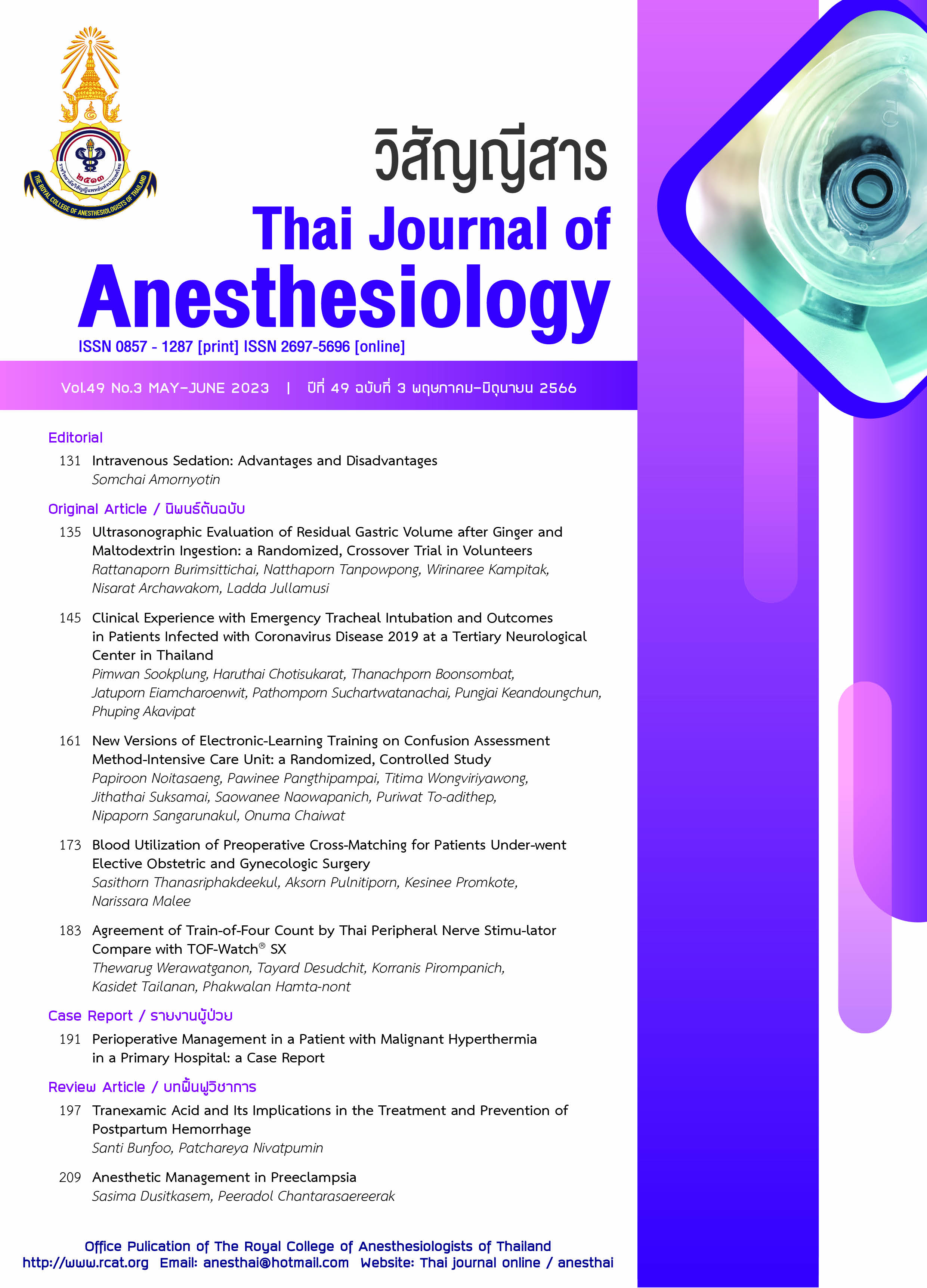Agreement of Train-of-Four Count by Thai Peripheral Nerve Stimulator Compare with TOF-Watchâ SX
Main Article Content
Abstract
Background: The incidence of residual neuromuscular blockade after general anesthesia is high. There are recommendations to monitor neuromuscular function during anesthesia with muscle relaxants, but clinical implementation is still low. One of the reasons is the availability of the low-cost equipment. The objective of this study aims to evaluate the train-of-four (TOF) count by the Royal College of Anesthesiologists of Thailand (RCAT) peripheral nerve stimulator side by side with the TOF-Watch® SX. Methods: We studied patients undergoing general anesthesia with non-depolarizing neuromuscular blocking agents. Every patient was given train-of-four stimulation with both peripheral nerve stimulators 15 seconds apart. Videos were recorded and randomly interpreted later to evaluate the agreement of the train-of-four count. Results: We obtained 269 pairs of data from 53 patients. Most of TOF count from TOF-Watch®SX and RCAT peripheral nerve stimulators in each pair was nearly the same with a weighted kappa coefficient of 0.9076 (95% confidence interval 0.8753-0.9399, P<0.001). Conclusion: This study shows TOF count from TOF-Watch® SX and RCAT peripheral nerve stimulator has high agreement. RCAT peripheral nerve stimulator is simple and cost-saving, which can promote its use for neuromuscular blockade moni-toring during anesthesia. Further improvements to add quantitative measurement will be beneficial.
Article Details

This work is licensed under a Creative Commons Attribution-NonCommercial-NoDerivatives 4.0 International License.
References
Naguib M, Kopman AF, Ensor JE. Neuromuscular monitoring and postoperative residual curarisation: a meta-analysis. Br J Anaesth. 2007;98:302-16.
Murphy GS, Szokol JW, Avram MJ, et al. Intraoperative acceleromyography monitoring reduces symptoms of muscle weakness and improves quality of recovery in the early postoperative period. Anesthesiology. 2011;115:946-54.
Todd MM, Hindman BJ, King BJ. The implementation of quantitative electromyographic neuromus-cular monitoring in an academic anesthesia department. Anesth Analg. 2014;119:323-31.
Murphy GS. Neuromuscular monitoring in the perioperative period. Anesth Analg. 2018;126:464-8.
Giudici G, Piccioni F, Proto P, Valenza F. A comparison of accelerometric monitoring by TOF Watch® SX and electromyographic monitoring by Tetragraph® for recovery from neuromuscular blockade. J Clin Anesth. 2021;75:110481.
Machado ES, Keli-Barcelos G, Dupuis-Lozeron E, Tramèr MR, Czarnetzki C. Assessment of sponta-neous neuromuscular recovery: a comparison of the TOF-Cuff® with the TOF Watch SX®. Acta An-aesthesiol Scand. 2020;64:173-9.
Iwasaki H, Yamamoto M, Sato H, et al. A comparison between the adductor pollicis muscle using TOF-Watch SX and the abductor digiti minimi muscle using TetraGraph in rocuronium-induced neuromuscular block: a prospective observational study. Anesth Analg. 2022;135:370-5.
Naguib M, Kopman AF, Lien CA, Hunter JM, Lopez A, Brull SJ. A survey of current management of neuromuscular block in the United States and Europe. Anesth Analg. 2010;111:110-9.
Checketts MR, Alladi R, Ferguson K, et al. Recommendations for standards of monitoring during anaesthesia and recovery 2015:
Association of Anaesthetists of Great Britain and Ireland. Anaesthesia. 2016;71:85-93.
Naguib M, Brull SJ, Kopman AF, et al. Consensus statement on perioperative use of neuromuscular monitoring. Anesth Analg. 2018;127:71-80.
Murphy GS. Residual neuromuscular blockade: incidence, assessment, and relevance in the postoperative period. Minerva Anestesiol. 2006;72:97-109.
Werawatganon T, Desudchit T, Sopavanit J, Pirompanit K, Tengwongderm K, Karin A. Evaluation of the accuracy and electrical properties of the Thai peripheral nerve stimulator for neuromuscular blockade assessment. Thai J Anesthesiol. 2020;46:15-9.
McHugh ML. Interrater reliability: the kappa statistic. Biochem Med (Zagreb). 2012;22:276-82.
Vanbelle S. A new interpretation of the weighted kappa coefficients. Psychometrika. 2016;81:399-410.
Bhananker SM, Treggiari MM, Sellers BA, Cain KC, Ramaiah R, Thilen SR. Comparison of train-of-four count by anesthesia providers versus TOF-Watch® SX: a prospective cohort study. Can J Anaesth. 2015;62:1089-96.
Naguib M, Kopman AF. Neuromuscular monitoring: keep it simple! Anesth Analg. 2019;128:1063-4.
Bruintjes MH, van Helden EV, Braat AE, et al. Deep neuromuscular block to optimize surgical space conditions during laparoscopic surgery: a systematic review and meta-analysis. Br J Anaesth. 2017;118:834-42.
Hudes E, Lee KC. Clinical use of peripheral nerve stimulators in anaesthesia. Can J Anaesth. 1987;34:525-34.
Lee CM. Train-of-4 quantitation of competitive neuromuscular block. Anesth Analg. 1975;54:649-53.
Naguib M, Brull SJ, Johnson KB. Conceptual and technical insights into the basis of neuromuscular monitoring. Anaesthesia. 2017;72 Suppl 1:16-37.
Lien CA, Kopman AF. Current recommendations for monitoring depth of neuromuscular blockade. Curr Opin Anaesthesiol. 2014;27:616-22.
Yamamoto S, Yamamoto Y, Kitajima O, Maeda T, Suzuki T. Reversal of neuromuscular block with sugammadex: a comparison of the corrugator supercilii and adductor pollicis muscles in a randomized dose-response study. Acta Anaesthesiol Scand. 2015;59:892-901.
Heier T, Hetland S. A comparison of train-of-four monitoring: mechanomyography at the thumb vs acceleromyography at the big toe. Acta Anaesthesiol Scand. 1999;43:550-5.
Simic-Krstic J, Kalauzi A, Ribar S, Lazovic G, Radojicic R. Electrical characteristics of female and male human skin. Arch Biol Sci. 2012;64:1165-71.


